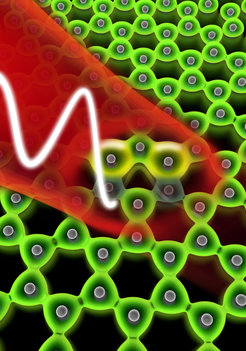High-speed march through a layer of graphene
In cooperation with the Center for Nano-Optics of Georgia State University in Atlanta (USA), scientists of the Laboratory for Attosecond Physics of the Max Planck Institute of Quantum Optics and the Ludwig-Maximilians-Universität have made simulations of the processes that happen when a layer of carbon atoms is irradiated with strong laser light.

The closer we observe the motion of electrons, the better we understand their interaction with light. Many phenomena that arise in condensed matter due to strong-field light-matter interaction are not yet fully understood. As the underlying processes occur within femto- or even attoseconds, it is difficult to access this intra-atomic cosmos: a femtosecond is a millionth of a billionth of a second; an attosecond is even a thousand times shorter. Experimental methods that shall cope with this challenge are at a development stage. However, it is possible to investigate these processes with the help of numerical simulations.
The team of scientists from LAP and Georgia State University has calculated what happens to electrons in graphene interacting with an intense laser pulse. The laser field excites and displaces electrons, changing thus the charge density distribution. During this process, an extremely short electron pulse is scattered off the probe. The diffraction map of these matter waves reflects how the electron density distribution inside the graphene layer has been altered because of the laser pulse.
These simulations have revealed complex relations between the excitation of valence electrons by light and their subsequent ultrafast motion inside and between the carbon atoms in the graphene layer. Valence electrons are weakly bound and shared among neighbouring atoms. The scientists investigated their motion by identifying microscopic volumes that represent various chemical bonds and analysing the electric charge contained in these volumes. During a laser pulse, there is a significant redistribution of the charge; at the same time, the displacement of the electrons caused by the electromagnetic field of the laser pulse is very small, less than a picometre (10-12 m). In addition to that, the calculations showed that the light-induced electric current has an inhomogeneous microscopic distribution, flowing along the chemical bonds between the carbon atoms.
These simulations should assist new ultrafast electron diffraction measurements. “We will possibly detect new phenomena, and perhaps observe deviations from our predictions”, project leader Vladislav Yakovlev points out. “But we are pretty sure that quite some fundamental physics is waiting to be observed in challenging but feasible atomic-scale measurements.” Thorsten Naeser/Olivia Meyer-Streng












